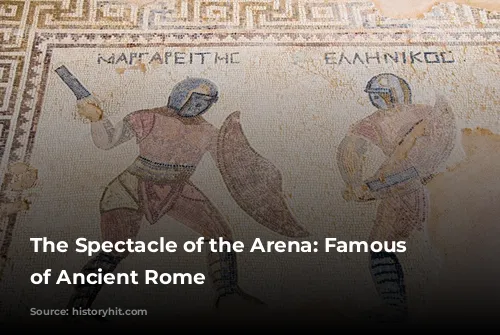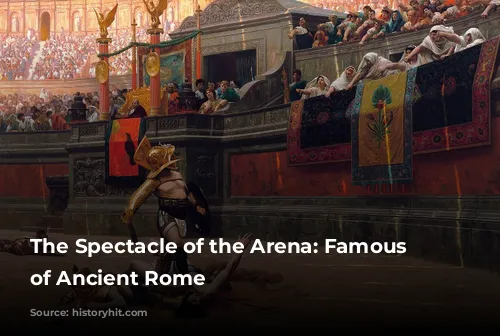Gladiatorial combat was a huge sensation in ancient Rome. These warriors were not just fighters but celebrities, often achieving immense wealth and admiration. Although there are limited written accounts of their battles, we can glimpse their lives through graffiti, inscriptions, and artistic relics.

More Than Just Entertainment: The Politics of the Arena
The image of gladiators battling in the arena dominates our understanding of ancient Roman entertainment, thanks to iconic movies like “Spartacus” and “Gladiator,” as well as paintings like Jean-Léon Gérôme’s “Pollice Verso.” These portrayals have cemented figures like Spartacus, the rebellious slave, and Emperor Commodus, the gladiator-emperor, as legendary figures. However, there were many other gladiators who rose to fame in their own time.

A Glimpse into the History of Gladiatorial Combat
The earliest large-scale public entertainment in Rome dates back to 264 BC, held at the Forum Boarium. By the 1st century BC, these spectacles had become a powerful tool for politicians to gain public recognition and prestige. It was during this period that Spartacus, perhaps the most famous Roman gladiator, trained in a gladiator school.
Spartacus: The Rebellious Gladiator
Spartacus’s fame stems from his leadership of a rebellion in 73 BC, leading an army of escaped slaves against the Roman Republic. This powerful army resisted the Roman legions for years, instilling fear in the hearts of Romans until the praetor Licinius Crassus took charge. Ultimately, Spartacus’s rebellion was crushed, and 6,000 of his freed slaves were crucified along the Appian Way.
The Legacy of Spartacus: Crixus and the Gladiator Revolt
One of Spartacus’s key lieutenants was a man named Crixus. According to Livy, Crixus and Spartacus led the revolt of gladiators from their gladiator school in Capua. In 72 BC, Crixus was tragically killed in battle by Quintus Arrius, along with 20,000 of his men. In honor of Crixus, Spartacus ordered the slaughter of 300 Roman soldiers.
The Games and the Spectators: A Pastime Not for Everyone
Roman sports, known as the ludi, were purely for spectators. While audiences valued athleticism and technique, they were not allowed to participate. In fact, Roman society viewed sportsmen and performers with disdain, seeing them as effeminate and “Greek.” Any Roman citizen who participated in or married a sportsman faced social stigma.
Commodus: The Emperor-Gladiator
Despite the disapproval, Emperor Commodus, who reigned from 176 to 192 AD, embraced the gladiator’s role, entering the arena himself. According to Cassius Dio, Commodus fought gladiators armed with wooden swords while he used a lethal steel weapon.
The Emperor’s Demise: A Conspiracy of Fear
Commodus’s reign ended tragically when he was assassinated by senators, who feared being humiliated by the emperor. Just a day before Commodus was set to accept honors while dressed as a gladiator, senators bribed the wrestler Narcissus to strangle Commodus during his bath.
Other Notable Gladiators: Flamma, Spiculus, and Priscus
While Spartacus and Commodus are legendary figures, other gladiators achieved fame and recognition in their own right. Flamma, a Syrian gladiator who fought during the reign of Hadrian in the early 2nd century AD, is notable for his remarkable record: 34 fights in the arena, winning 21, and refusing freedom four times.
Spiculus, a favorite of Emperor Nero, was showered with wealth and land, even receiving “properties and residences equal to those of men who had celebrated triumphs,” according to Suetonius. Nero even requested Spiculus to end his life, highlighting the gladiator’s close relationship with the emperor.
Martial, a Roman poet, provided a unique glimpse into a gladiatorial match in his epigrams. He described an epic confrontation between the rivals Priscus and Verus, the main event of the Colosseum’s opening in 79 AD. The two gladiators fought for hours, eventually laying down their weapons and leaving their fate to the Emperor Titus, who granted them their freedom.
The Life and Death of a Gladiator: From Debt to Fame
Marcus Attilus, whose name is recorded in Pompeii’s graffiti, may have entered the arena to pay off his debts. He rose to fame after defeating a man who had won 12 out of 14 fights and then defeated another opponent with an impressive record. Interestingly, gladiators with longer careers were less likely to face death in the arena, as the audience preferred evenly matched fights.
Tetraites: A Gladiator Across the Empire
Pompeian graffiti mentions Tetraites, a bare-chested gladiator who was popular across the Roman empire. His battles were recorded on glass vessels, including one found in southeast France, documenting his fight against gladiator Prudes.
Women in the Arena: Amazon and Achilla
While the Roman games were heavily gendered, two female gladiators, Amazon and Achilla, are depicted on a marble relief from Halicarnassus in Turkey. This was seen as a scandalous transgression, and Roman writers condemned the practice as vulgar. The relief shows the women heavily armed, signifying their participation in the arena. Interestingly, the inscription states that both Amazon and Achilla were granted a reprieve before the end of their combat.
Marcus Antonius Exochus: A Gladiator’s Retirement
Marcus Antonius Exochus, a gladiator born in Alexandria, Egypt, traveled to Rome to fight in games celebrating Trajan’s posthumous triumph in 117 AD. His fragmentary tomb records that he fought a slave named Araxis in his first combat and received “missio,” a privilege that stopped the fight before either fighter was killed. This suggests that Exochus may not have been exceptionally renowned, but he was able to retire as a Roman citizen.
Conclusion: The Lasting Legacy of Gladiators
From the rebellion of Spartacus to the tragic fate of Commodus, the stories of gladiators offer a glimpse into the social and political landscape of ancient Rome. These warriors were not just entertainers but symbols of power, rebellion, and the complex dynamics of Roman society. Their lives and legacies continue to capture our imagination, reminding us of the enduring power of the gladiatorial spectacle.
